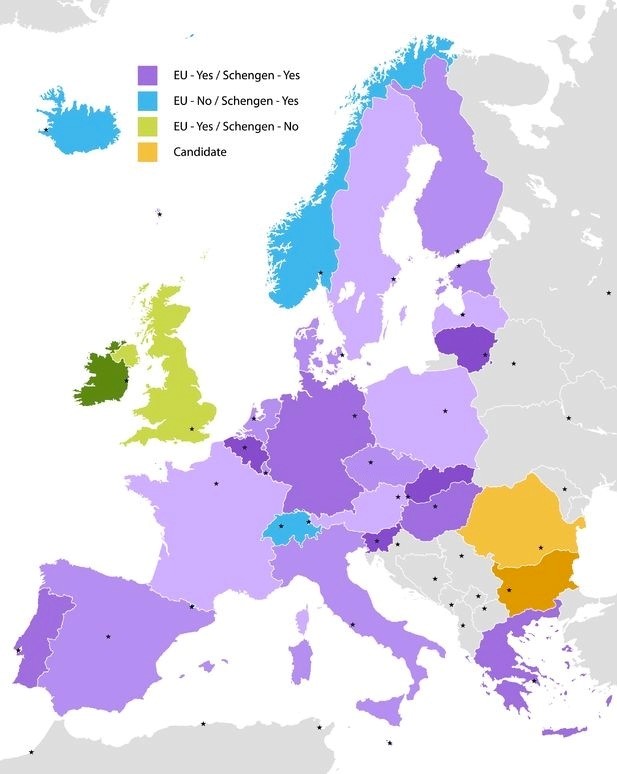Blog

What is a Schengen Visa and do I need one?
03-09-2015

If you live outside the EU and want to visit the Schengen area then you will probably need to apply for a Schengen Visa.
What is a Schengen visa?
A Schengen visa is a document that allows you to visit and travel within the Schengen area. The visa is issued to you by the appropriate authorities.
Where is the Schengen area?
The Schengen visa zone is comprised of 26 countries: 22 are part of the EU (European Union) and 4 are part of the EFTA (European Free Trade Association).
The Schengen area covers the majority of European countries, except for the United Kingdom (UK) and Ireland. Some countries that are not part of the EU (Norway, Iceland, Switzerland and Lichtenstein) also belong in the Schengen area. Countries such as Romania, Bulgaria, Croatia, Cyprus and Ireland are soon to be part of the Schengen visa zone agreement.
List of countries in the Schengen area
- Austria (EU and Schengen)
- Belgium (EU and Schengen)
- Czech Republic (EU and Schengen)
- Denmark (EU and Schengen)
- Estonia (EU and Schengen)
- Finland (EU and Schengen)
- France (EU and Schengen)
- Germany (EU and Schengen)
- Greece (EU and Schengen)
- Hungary (EU and Schengen)
- Iceland (Schengen Only)
- Italy (EU and Schengen)
- Latvia (EU and Schengen)
- Lithuania (EU and Schengen)
- Luxembourg (EU and Schengen)
- Malta (EU and Schengen)
- Netherlands (EU and Schengen)
- Norway (Schengen Only)
- Poland (EU and Schengen)
- Portugal (EU and Schengen)
- Slovakia (EU and Schengen)
- Slovenia (EU and Schengen)
- Spain (EU and Schengen)
- Sweden (EU and Schengen)
- Switzerland (Schengen Only)
- Liechenstein (Schengen Only)
Do I need a Schengen visa?
Below is a map of the world with a chart to show you if you would need to get a visa to visit the Schengen Zone. Before visiting the Schengen Area, always check with the relevant embassy to ensure that:
- You definitely need to apply for a visa, and
- You have the correct information/documents to make a successful application.
Which embassy should I apply to?
If you are visiting one country only:
You need to apply for a visa from the embassy of the country you intend on visiting. For example, if you intend on visiting Germany, you would go to the German Embassy.
If you are visiting multiple countries within the Schengen Area:
If you are visiting many countries for an unknown or similar length of time, then you must apply to the first country you are going to. As long as the visa bureaucracy is the same, it may be possible to use one visa for multiple entries within Schengen countries.
If you will be visiting one country for a significantly longer period than others, you should apply to the embassy of that country.
How do I apply for a Schengen Visa?
1. Complete the application form:
- The application form is the same no matter which country you are visiting.
- Any mistakes or dishonest answers will result in you being unable to get the visa.
- You can complete the form by hand writing your answers in black ink only, or by using a computer to type the answers on to the form.
- You must make sure that you keep within the boxes and do not leave any blank boxes.
- If the question does not relate to you then place an NA (Not Applicable) in the box.
- The applicant will also need to sign the form in the correct places.
- If the applicant is a minor (under 18 years old), then the parent(s) must submit a written consent and also sign the corresponding column on the application form.
- You will need to state if you require a single or multiple entry visa at this point. A multiple visit visa is useful if you plan on visiting the Schengen zone more than once, or visiting more than one country within the Schengen Zone, within a three month period.
2. Book an appointment at the appropriate embassy:
- Search for the correct Embassy/Consulate for the country you would be visiting. They will inform you about their specific application/appointment procedure.
- To avoid disappointment it is recommended to apply as soon as you can. This should be a minimum of 15 days before your departure – this is the approximate time an Embassy/Consulate needs to complete the visa issuing process – and a maximum of 12 weeks before you travel.
- Check the appointment system at the embassy. Some embassies allow walk-in appointments whilst others require a pre-booked appointment. If you are planning to travel on a short term visa, the appointment must be made no more than 6 weeks in advance. This rule doesn’t apply to the applicants who are applying for a long-term visa.
Can I apply for a Schengen visa in a country where I am not resident?
As long as your reason is valid, for example you are currently studying in the UK, then yes.
You must attend your pre-booked appointment with your completed application form and supporting documentation. At the consulate you may only be accompanied by an adult if you are a minor (under 18), have sensitive health or are unable to perform any locomotive activity.
If you are unable to speak the language of the country you are applying to, or English then it is recommended to use a company that may help you.
What documents will I need for my visa application?
Every Schengen country have different application requirements. Please check when booking your appointment what documents you need to provide.
A general example of what documents are needed with the additional information is meticulously described and listed below:
- The application form must be fully completed and signed in the corresponding blanks.
- One photo is to be attached; the photo must have a passport format, full-face capture, and a light background. The photo must be recently taken.
- The passport as well as all the copies of your previous visas, valid for at least 3 months prior to your departure is required. The passport must have at least two blank pages.
- One must have a copy of the reservation of the return ticket for the time intended to be travelling. It is not recommendable to buy the ticket before getting the visa, if not necessary.
- A travel medical insurance policy needs to be secured, covering any medical emergency with hospital care and travel back to your native country due to medical motives. This health insurance policy has to cover expenses up to 30,000 euros, the sum depending on the residing days, and also it has to be valid in all Schengen countries. The health insurance policy must be purchased before picking up the visa and if your visa is refused you can cancel it!
If you are visiting Family or Friends in the country you applying to, then you will need to provide the following:
- If you are covering the expenses while in the country you need to show 6 months bank statements to prove you have the funds.
- If a family member or friend is funding your visit then a formal document which would be issued by the relevant authorities to the Schengen resident.
- The formal invitation from the friend or family member
- If you are funding the visit then you will need to provide the name, address and copy of their passport. If the friend/relative is not a resident of the Schengen country then you will need to provide a copy of the residency permit.
Tourist travel (not visiting family or friends)
- Your bank statement to show you have enough funds for your visit (6 months bank statements)
- Detailed itinerary of the travelling days (flights and other journeys) in the Schengen zone, all accommodation bookings or formal invitation letter by a resident of a Schengen country. This could be a school or travel company.
What happens at my appointment?
- You will need to show your application form (including a passport picture) and supporting documentation to the clerk behind the counter.
- You will have an interview where they will ask you some questions about you (e.g. your address), and your planned trip (why you are travelling, where you are visiting, travel details, accommodation). You must know your plans, otherwise they may decline your application.
- If you pass this stage, you will need to pay the visa fee for staff to process your application. This is usually by card, but full details are available on the application form and/or the website of the place of application. Please check beforehand! The fee could differ from country to country due to exchange rates and value of the home currency to the Euro or the country you are visiting.
- After payment, you can leave the visa office.
- If they require further documentation or a further interview they will contact you and ask you to visit them and provide the information that they need.
- You will be notified when you will be able to collect your visa (and passport) from the visa application centre/Embassy/Consulate. If you cannot collect your visa yourself, you may nominate Study Links to collect your passport and visa from the processing centre in the UK. Outside the UK you can nominate a person, in your country, to collect the visa. To nominate someone else to collect your visa, you will need to provide them with a letter authorising them to collect the visa (and passport) on your behalf. They will also need the receipt and stamped passport copy that was given to you by the officer interviewing you.
I’ve received me visa, what next?
Once you have received your Schengen visa you are free to visit the Schengen area (please see map). There will be a valid from and valid to date so please make sure that you are using the visa between these dates.
Do I need a Schengen Visa to only visit the UK?
No. Ireland and the UK, in addition to some other overseas territories of EEA member states, have opted out of the EU’s visa policy. They therefore operate their own separate visa policies.
If you require a Schengen visa and need help applying and or collecting the visa please feel free to contact applications@studylinks.co.uk
The information provided by Study Links cannot be used as an alternative to legal advice from an appropriately qualified professional. If you have any specific questions about any legal/visa matters please contact the UKVI or a Visa and Immigration expert. Please contact Study Links and we will offer you details of some of the companies we work in partnership with. Information correct at time of publication (September 2015).
References:
Euro/Schengen map – http://www.schengenvisainfo.com/
World map – “Schengen visa requirements” by Alinor at English Wikipedia. Licensed under CC BY-SA 3.0 via Commons.

